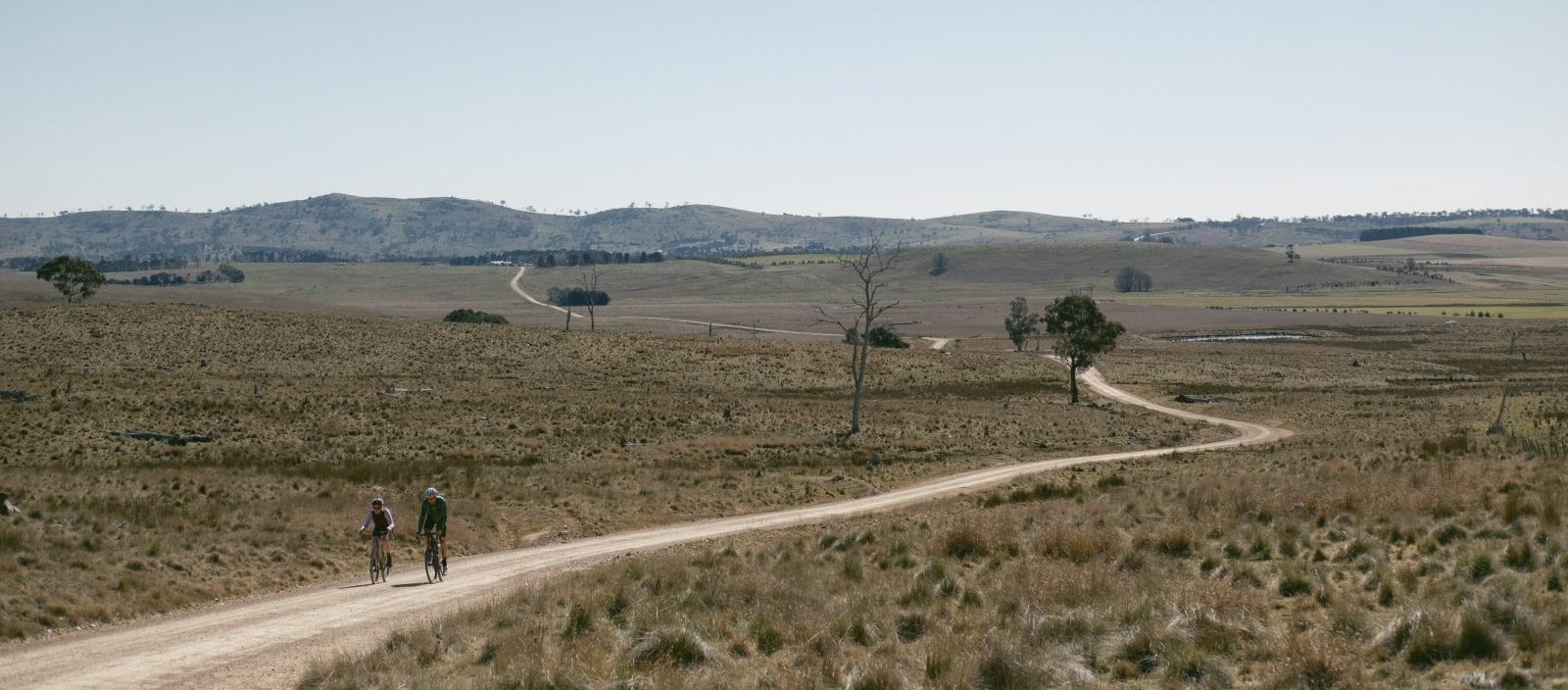Four days in Ehime riding epic routes like the Shimanami Kaido, Mount Ishizuchi, UFO Line and more
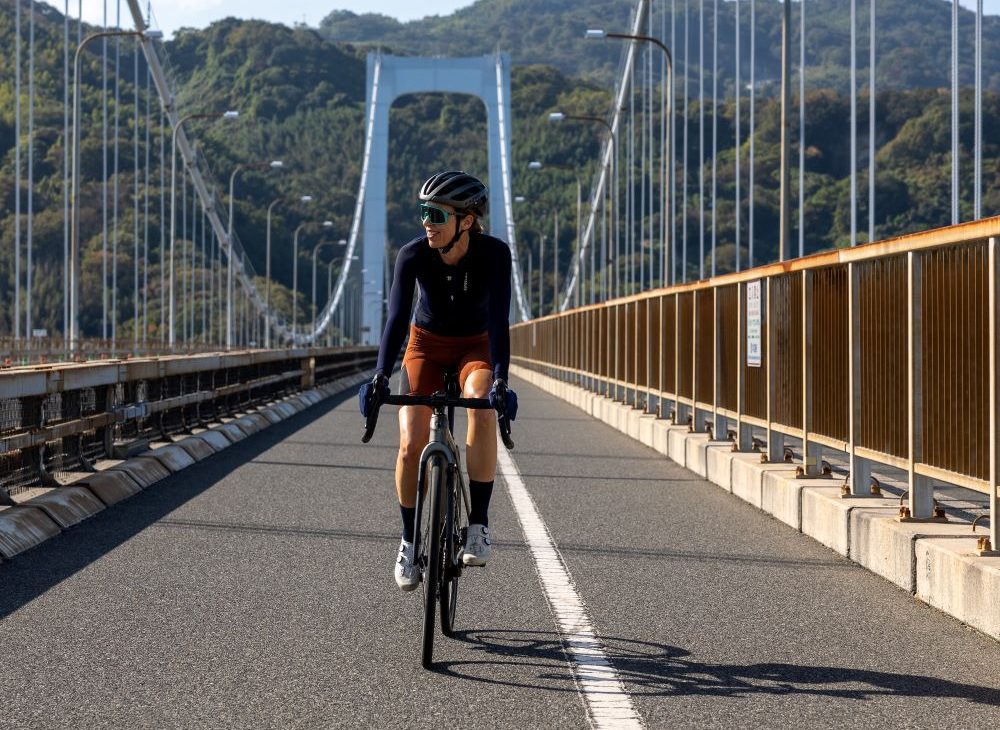
Ehime might be most famous for the Shimanami Kaido, but the province, located on Shikoku Island, a one-hour flight from Tokyo, has so much more to offer cyclists than the famous white bridges.
Ehime also boasts high alpine mountains, historic castle towns and magnificent river gorges, all of which our group took in over four days of cycling along bike paths, forest ways and quiet roads, with the odd major route thrown in.
But first: onsen
A small group of Aussie cyclists, we kick off our trip with some team-building – Japanese style. Fresh off the jet, we head to Dogo Onsen, a short drive from Matsuyama airport.
Dogo Onsen is said to be the oldest onsen in Japan, with 3,000 years of history, and if you’re an anime fan, it’s also said to have inspired the buildings in Spirited Away.
The heritage-listed main baths building, built in 1894, is three stories high and constructed with traditional timber methods.
Inside, we collect towels and toiletries and descend into a labyrinth of narrow wooden staircases to the communal bathing rooms.
Onsen bathing has a strict set of rituals and protocols, which we do our best to adhere to, publicly scrubbing like we’ve never scrubbed before, then stepping into the ancient waters, heated to around 39 degrees by geothermal springs.
We sit and avoid eye contact. We are, after all, completely nude. Our travel aches eased by the onsen’s healing minerals, we head to our hotel to build bikes and get going.
In Ehime, cycling is a key attraction, and Imabari station is a hub for riders setting off on the Shimanami Kaido, the most famous route in the prefecture.
Imabari station is as much a bike station as a railway station, with huge bicycle retail and rental space, and generous, sparkling clean end-of-trip facilities (this is Japan, after all).
Our hotel, too, is bike-friendly, with in-room bike hooks, pumps on every floor, and generous buffet breakfasts – without which no bike tour would ever really succeed.
Our bikes built, we’re ready for four days riding some of the best routes in the world.
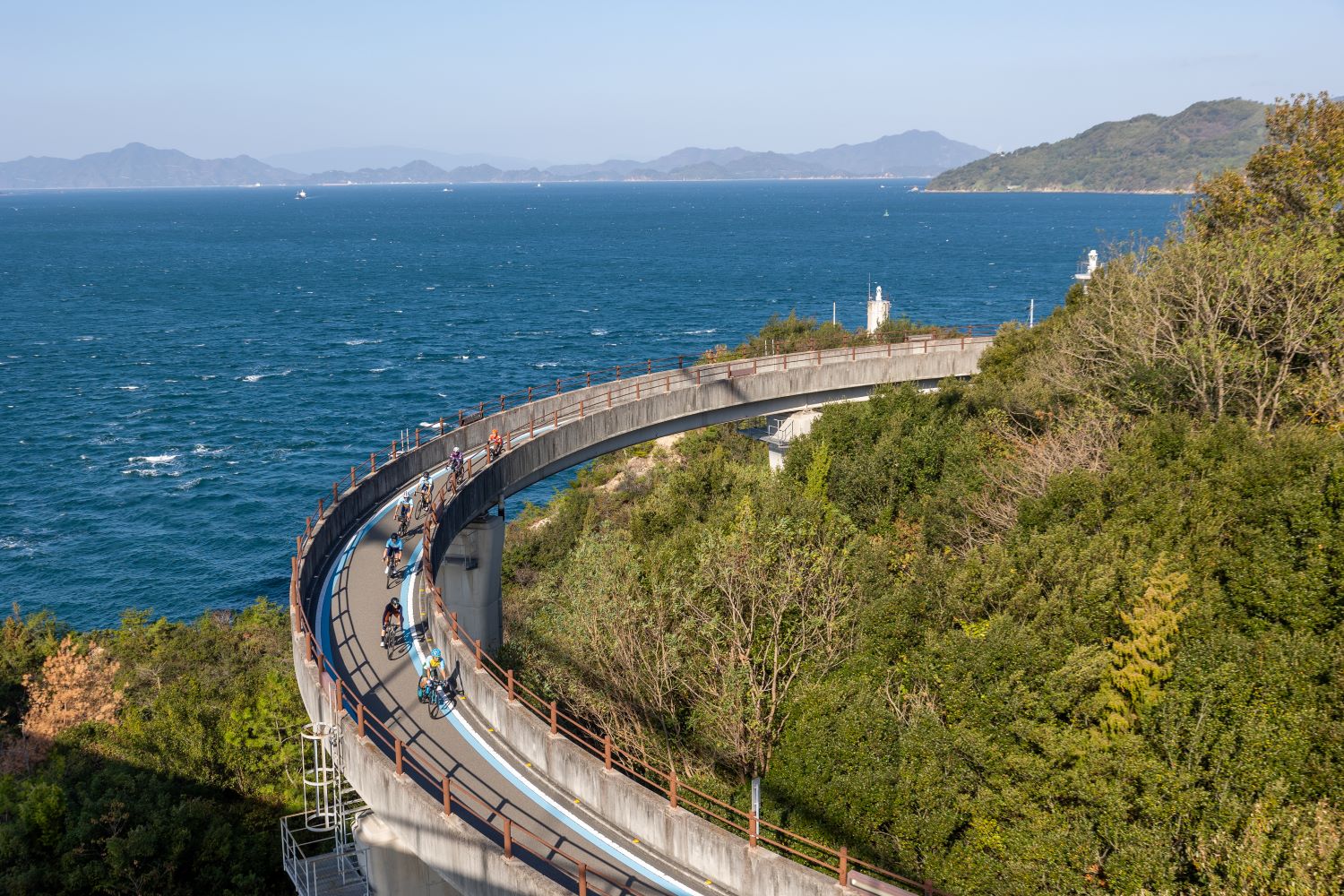
The Shimanami Kaido
Riding across a massive structure, far beyond human scale, really helps you appreciate the ingenuity of human engineering.
By which I mean I’m grateful we invented bicycles so that we can enjoy our surroundings, unmediated by a windscreen.
We’re dropped off at the Sunrise Itoyama Cycling Station, again equipped with pumps, bike stands, and tools, and head off across the Kurushima Kaikyo bridge, which spans the Seto inland sea between mainland Shikoku and Oshima Island.
When it was opened in 1999, this was the biggest suspension bridge in the world. Steel cables sing in the sea route’s famous winds, and looking up, the towers are dizzying.

We stop over and over again, overwhelmed by the scale of the views of coastline, and a vast green sea dotted with volcanic islands.
The Shimanami Kaido links Shikoku with Japan’s largest Island, Honshu, and believe it or not, was actually built for cars.
Twenty-five years after its construction, the road is now one of the most recognisable cycling routes in the world, and at 140km return is an appealingly chunky one-day ride challenge.
We take our time, spending nearly a full day out enjoying the sea breezes and pancake-flat route – so flat that the ramps on and off the bridges look like mountains on our GPS profiles. At lunchtime, we have bento boxes by the beach and visit a Shinto shrine dedicated to safety and wellbeing in transport, each making a wish and buying protective helmet stickers to keep us safe on our rides.
We finish with a ride up a proper hill to the Kirosan Observatory, which offers panoramic, 360-degree views of the Shimanami route’s famous bridges, islands and coastline.
After beer and chicken skewers at an izakaya bar, we turn in at the Itomachi Hotel 0 in Saijo. Recently opened, the net-zero hotel is a meeting of the ultra modern and creature comforts, with a ridiculously nice breakfast. Which we’ll need.

The mountains
After tracing a mossy, leafy forest road for a few kilometres, we emerge on sub alpine slopes, traversing tiny, bare-rock tunnels and catching glimpses of wild Japanese monkeys.
We follow some of the roads of the Mt Ishizuchi Hill Climb event, a famous race in Japan which takes riders up 850 metres of elevation in just 18km, topping out at about 1,500m elevation, As we climb upwards, the leafy hills give way to alpine grasslands, and the hillsides open to vistas of tall, volcanic mountains stretching to the horizon.
At the top of the ridgeline we follow the UFO line, which traces the border between Kochi and Ehime prefectures, running for 27km of perfect rolling alpine scenery, with views of the sacred Mt Ishizuchi, the highest mountain in Western Japan (1,982m).
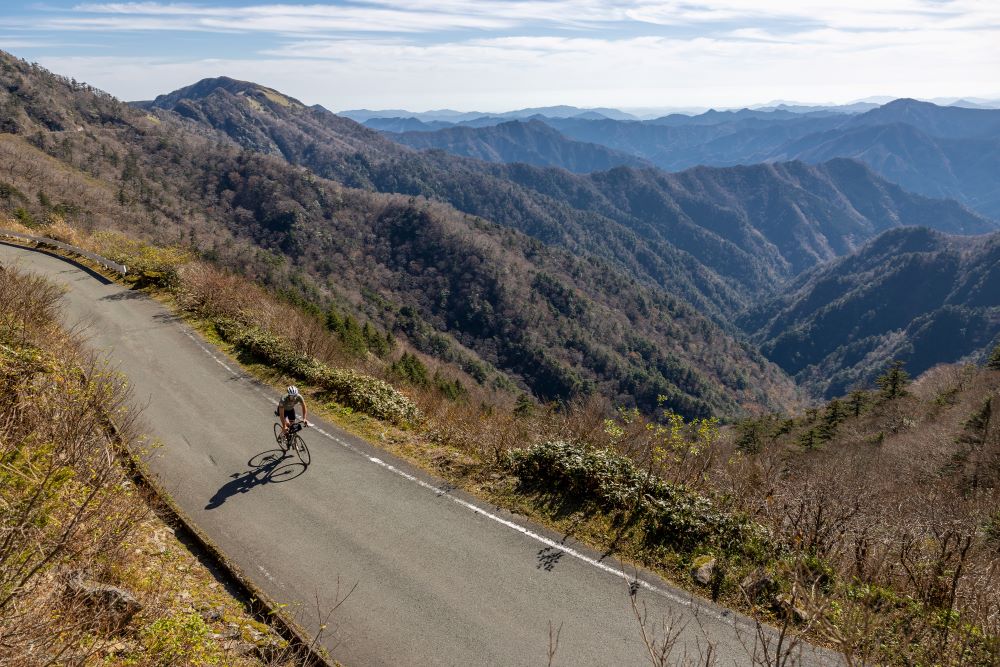
After a quick stop for an incredible lunch of local somen noodles, we head off for the descent, swooping down swaying corners into a deep valley of green, gold, and auburn leaves, the wide and endless road all to ourselves.
Pulling in at the historic castle town of Ozu, many of us experience traditional Japanese Ryokan hospitality for the first time.
We dress in our yukata, or traditional Japanese robes, don our split toe tabi socks and geta clogs, and are transported to a special degustation style meal called kaiseki, typical of Japanese guesthouse accommodation, using local ingredients and offering many, many courses.
The rivers
After a visit to Ozu’s hilltop castle, most of our climbing is done for the day. Our route takes us along the Okuiyo-Hiji River cycling course, alongside Ehime’s rivers, tracing its gorges into deeper and deeper valleys.
Here, autumn colours splash across adjacent hillsides, while blue-tinged currents swirl the waters below.
It’s a fast day of around 80km, gradually losing elevation as we leave the mountains behind us and head back to Uwajima, another historic town near the coast.
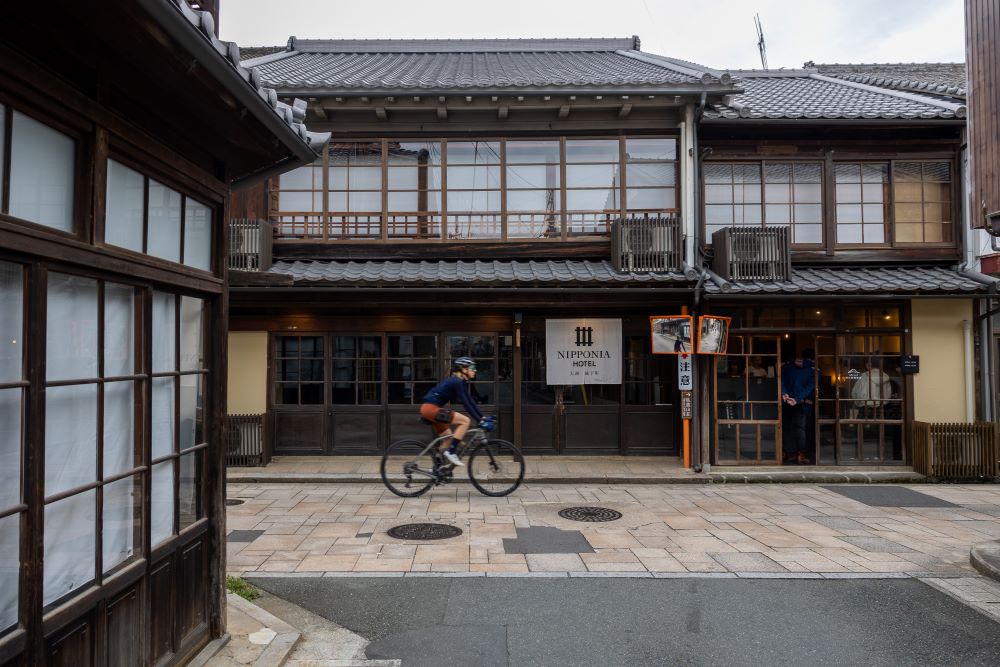
We pull up at the lovingly restored Kiya Ryokan and soak in its historic ambience before heading out for hyper-modern sushi dining at a sushi shinkansen (bullet) train staffed partly by robots who deliver your drinks and take your plates away.
Our last day comes too soon, with a quiet, final roll that takes us along the shores of the Uwakai coastline, where tranquil, still waters are home to pearl farms and fishing boats.
We head towards the Yusumizugaura terraced fields, where villagers carved farmland out of sheer cliffs over centuries, and eat our last local meal at a lunch spot popular among the small community of farmers and fishers, before packing our bikes and transferring back to the airport.
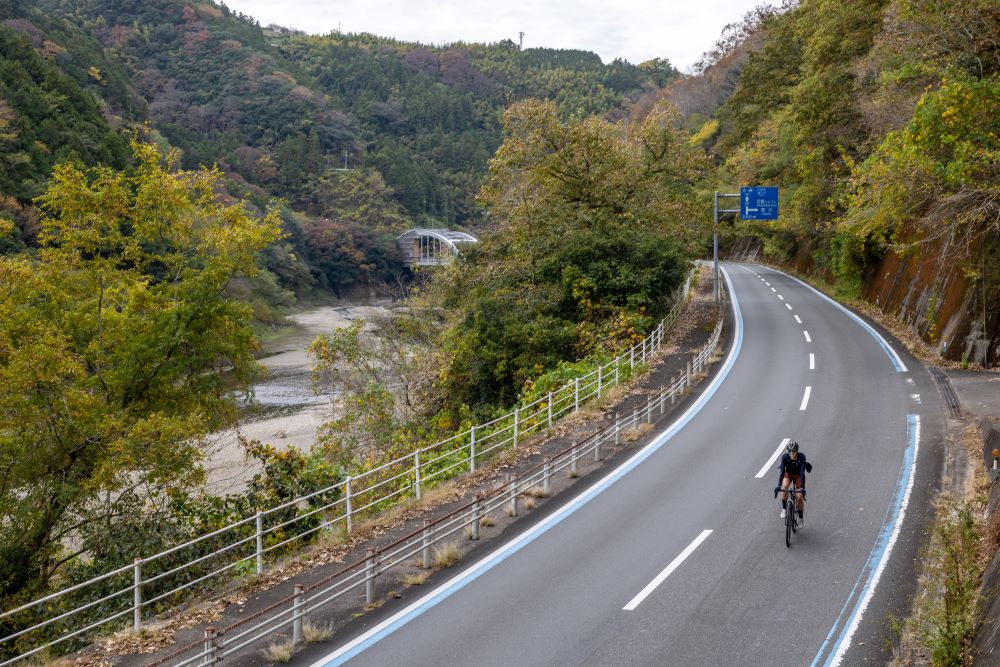
In just four days’ riding we’ve traversed the prefecture of Ehime and ticked off all the ingredients that make the perfect cycling holiday: great routes, amazing views, incredible local food and friendly hospitality. We’ve experienced the breadth of Japanese culture, from historic onsens and ryokans to cutting-edge green energy, vending machines that serve hot drinks in a can, and of course, robots.
The routes we took
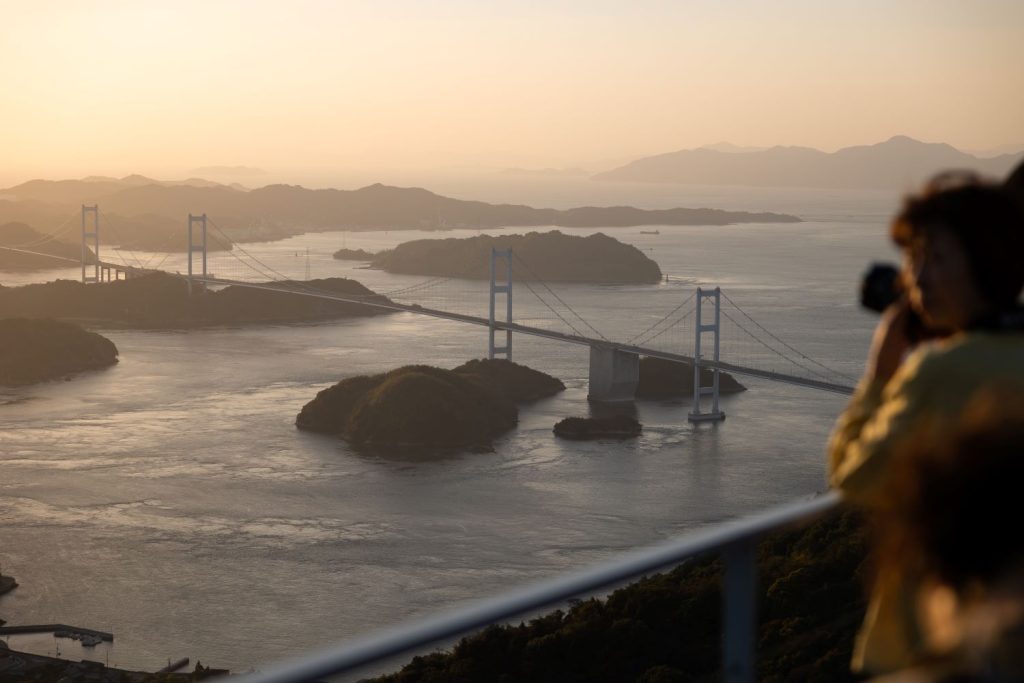
Follow in Cyclist’s wheel tracks
Each day of riding took us through vastly different terrain and vistas, from smooth coastline to dramatic mountains and cool, leafy gorges.
Day 1
We started at Sunrise Itoyama Cycling Station and completed an out-and-back section of the Shimanami Kaido route, crossing three islands before finishing up the intense climb to the Kirosan Observatory for incredible sunset views.
Day 2
We headed for the hills, riding across the Ishizuchi Mountain route, taking in incredible forest paths and epic valley descents through autumn colours.
Day 3
The group cycled down winding valleys along the Okuiyo Hiji river cycling route, finishing up in the town of Uwajima.
Day 4
We rolled along the historic Uwajima-Shimanto Terrace Fields cycling route, tracing glorious coastline where the mountains meet still bays famous for pearl farming, before taking in the famous Yusumizugaura terraced fields and stopping for a traditional lunch.
By the numbers
Because we all love stats
265
kilometres ridden
3
islands hopped
0
flat tyres – Japanese road quality is excellent 10,000+ Photo opportunities
1
communal bathing experience (great for team bonding) at the historic Dogo Onsen
Do it with Bike Odyssey
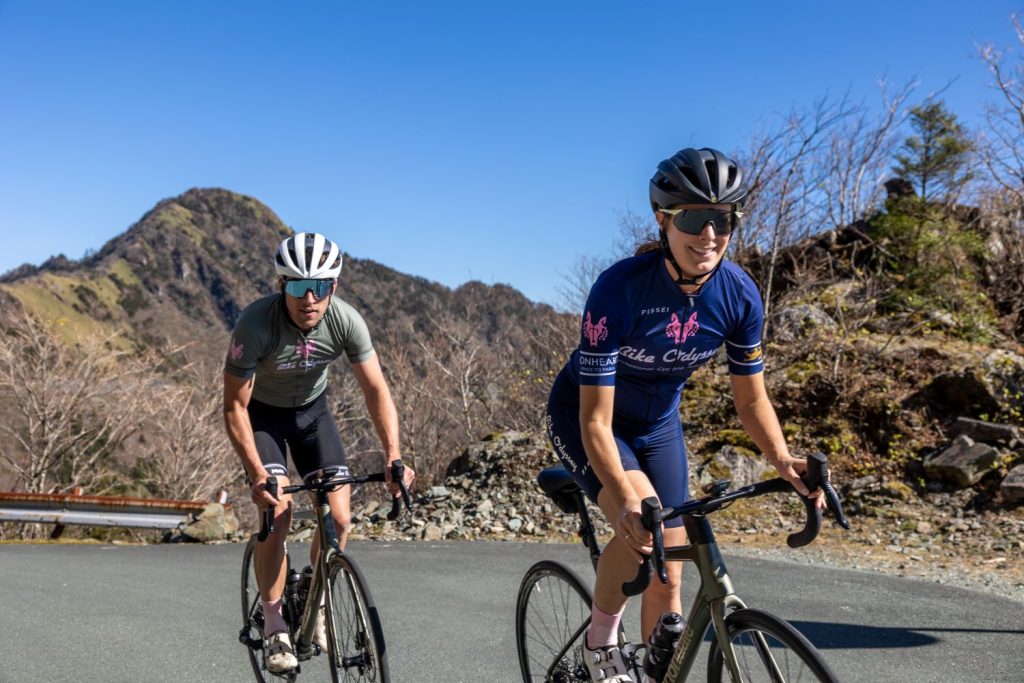
For more information visit bikeodyssey.cc/tours/japan
Want to experience everything you’ve seen here for yourself? Australian cycling tour operator Bike Odyssey will be offering two different tours of Japan in 2024 and beyond.
The first is a six-day tour of Ehime that includes the exceptional Japanese riding and culture that you’ve seen in this very booklet. You’ll experience the Shimanami Kaido, Mount Ishizuchi, the UFO line and much more.
The second is a 25-day odyssey through Japan’s modern and ancient cultures, following ancient kaidōs (historic routes) and epic cycling trails. It starts on revered and unmissable Mount Fuji, traversing Japan, finishing in rural, traditional and hidden Kyushu.
Along the way you’ll visit the Japanese Alps, Kyoto, Fukuoka and, of course, Ehime and the Shimanami Kaido. Featuring traditional Ryokan mixed with luxury accommodation, onsen springs to salve the legs and plenty of exceptional cuisine and fascinating history, Japan is the perfect destination for your next cycling odyssey.
How we did it
We flew with ANA airlines from Sydney to Haneda airport then took a domestic flight to Matsuyama airport.
While we were shuttled to some of the ride starts, all our overnight locations were bike friendly, with bike lanes and easy-to-follow routes to the start of each day’s riding, so doing this as a bike tour or bike packing trip are completely within reach.
The four towns we stayed in all featured unique, bike-friendly accommodation, each with their own taste of different facets of Japanese hospitality, from high tech to historic.
IMABARI
We stayed at the JR Clement Inn Imabari. This bike-friendly hotel boasts compact rooms with bike stands, pumps on every floor, full buffet breakfast with western options, and sits next to a huge bike station and bike hire/shop with tonnes of facilities for cyclists.
ITOMACHI
We stayed in Itomachi Hotel 0 – as the name implies, a net-zero hotel, completely powered by green energy.
Ultra-modern, the hotel had just opened. It featured clean, simple, perfect Japanese architecture and thinking, with everything you needed and nothing you didn’t, and a masterpiece of a breakfast.
OZU
A preserved ancient town with incredible Edo-period features, one of which is the Nipponia Hotel.
Here, we stayed in authentic ryokan (guesthouse) accommodation with individual luxurious baths and traditional tatami mat rooms. Dressed in yukata, we also enjoyed a French-inspired Japanese kaiseki, or banquet. This kind of meal offers a decadent menu of fresh ingredients, sourced locally.
UWAJIMA
A small town near beautiful historic coastline where we stayed at the special Kiya Ryokan, a building over 100 years old, revived and reimagined by an award-winning Japanese architect to include an internal atrium, decadent bathing room and flexible internal spaces.
Rented out by one group at a time, it reimagines the communal guesthouse of old-time Japan.


